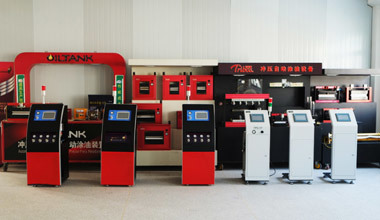News Center
An Oiling System Manufacturer Integrating Design, Production And Sales, With Its Own Brand TRIBOS, Has Been Committed To The Development And Production Of Precision Automatic Oiling Devices For Stamping Processing For Many Years
Oiling device: How to choose anti-rust oil for oiling device
Release time:
2021-02-07 14:03
Source:
www.tribos.cn
Nowadays, many cold-rolled steel mills use electrostatic oiling devices to apply antirust oil on cold-rolled steel plates, but the antirust oil used here is the special electrostatic oiling device antirust oil. According to the principle of "same-sex repulsion and opposite-sex attraction", charged particles are efficiently and evenly adsorbed on the steel strip passing in the direction of the power line under the action of electrostatic field, showing a unique "hugging effect". Electrostatic oiling device can also use positive corona discharge, but the critical voltage of negative corona discharge (starting voltage) is lower than positive corona discharge, which is stable, safe and not easy to produce sparks. The requirements of electrostatic oiling device for rust prevention oil is an insulating oil and has the following requirements:

(1) The appearance of the antirust oil of the electrostatic oiling device should be uniform and transparent, i.e. not turbid and not precipitated.
(2) The antirust oil of the electrostatic oiling device should be easy to be charged. At the same time, the oil resistance should be no less than 7 K-50 M, and the breakdown voltage at room temperature should be no less than 20 kV. Too little oil resistance will threaten the personal safety of the operator and reduce the safety and reliability of the equipment and the spray atomization effect.
(3) Refueling is carried out in a humid environment, and it is easy to let water mix into the oil. When the water content in the oil exceeds 0.05%, it will cause serious harm to the oil supply system. In addition, moisture tends to deteriorate the oil, and excessive water emulsifies the oil, which affects the antirust effect of the steel plate (belt) after oiling and also reduces the oil resistance value. Therefore, the water content in the oil is required to be no more than 0.03%.
(4) The suspended or precipitated solid impurities left in the oil will lead to wear and blockage of the oil supply pipeline parts, and will also affect the oiling quality of the oiling device. If the oil suction filter is blocked by impurities, it will lead to insufficient suction of the oil supply pump, cause cavitation, and cause vibration and noise of the oil supply pipeline; if the fine oil filter is blocked by impurities, the filter element may break and the impurities attached to the filter element may enter the post-filter pipeline. Therefore, it should be ensured that the content of impurities in the oil is not more than 0.005% and the particle size of impurities is not more than 0.01 mm, so that the oil filter of the oil supply system, the mandrel of the electromagnetic reversing valve and the slot of the oil injection port are not blocked by impurities.
(5) The oil should have good rust resistance and corrosion resistance. The oil shall not contain water-soluble acids and alkalis, so as not to corrode the oil supply line seal and oiling device steel plate (belt).
(6) The viscosity of the oil should not be too low or too high. Too high viscosity will reduce the self-priming ability of the oiling device oil pump, increase the pipeline oil delivery resistance, and even make the oil cannot flow out from the edge gap of the oil spray beam; too low viscosity will increase the leakage of the oil pump, control valve and pipe joint.

